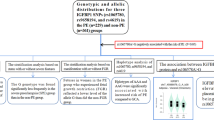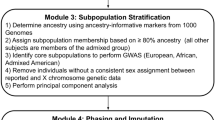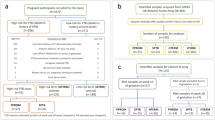Abstract
Objective:
Preterm birth (PTB) is a multifactorial complication in which genetic and environmental factors contribute to the phenotype. The AKAP10 protein encoded by AKAP10 gene has a vital role in the maintenance of myometrial quiescence and pregnancy. This study aimed to investigate whether polymorphisms in the AKAP10 gene are associated with the risk of PTB.
Study design:
A total of 664 women (132 preterm and 532 term) with spontaneous singleton deliveries were genotyped for AKAP10 polymorphisms (rs119672, rs203462 and rs169412) using Sequenom MassARRAY platform.
Result:
A significant association was observed between the CC and AC genotypes of AKAP10 rs169412 with reduced risk of PTB (CC: adjusted odds ratio (OR) 2.95, 95% confidence interval (CI): 1.23–7.09, P=0.016. AC: adjusted OR 3.46, 95% CI: 1.38–8.68, P=0.008), respectively. Following stratification by ethnicity, a significant association was observed between the AC and CC genotypes of rs169412 and term birth in the Malay ethnic subgroup. (CC: OR 2.9, 95% CI: 1.01–8.59, P=0.041. AC: OR 3.14, 95% CI: 1.04–9.54, P=0.043). A significant association was also observed between the CT genotypes of AKAP10 rs119672 with reduced risk of PTB deliveries (CT: OR 3.2, 95% CI: 1.06–9.76 P=0.007, TT: OR 2.8, 0.98–8.34, P =.0.015) Alternatively, there was no association between AKAP10 rs169412 and rs119672 polymorphisms with PTB in the Indians and Chinese ethnic groups.
Conclusion:
This study indicates a significant association between the AKAP10 polymorphisms and reduced risk of PTB in the Malays. This demonstrates the potential role of AKAP10 polymorphisms in preterm complications.
This is a preview of subscription content, access via your institution
Access options
Subscribe to this journal
Receive 12 print issues and online access
$259.00 per year
only $21.58 per issue
Buy this article
- Purchase on Springer Link
- Instant access to full article PDF
Prices may be subject to local taxes which are calculated during checkout

Similar content being viewed by others
References
Vogel J, Lee A, Souza J . Maternal morbidity and preterm birth in 22 low- and middle-income countries: a secondary analysis of the WHO Global Survey dataset. BMC Pregnancy Childbirth 2014; 14: 56.
Ward RM, Beachy JC . Neonatal complications following preterm birth. BJOG 2001; 20: 8–16.
Zhang Y-P, Liu X-H, Gao S-H, Wang J-M, Gu Y-S, Zhang J-Y et al. Risk factors for preterm birth in five maternal and Child Health Hospitals in Beijing. PLoS One 2012; 7: e52780.
Verli J, Klukovits A, Kormanyos Z, Hajagos-Toth J, Ducza E, Seres AB et al. Uterus-relaxing effect of beta2-agonists in combination with phosphodiesterase inhibitors: studies on pregnant rat in vivo and on pregnant human myometrium in vitro. J Obstet Gynaecol Res 2013; 39: 31–39.
Price SA, Bernal AL . Uterine quiescence: the role of cyclic AMP. Exp Physiol 2001; 86: 265–272.
MacDougall MW, Europe-Finner GN, Robson SC . Human myometrial quiescence and activation during gestation and parturition involve dramatic changes in expression and activity of particulate type II (RII alpha) protein kinase A holoenzyme. J Clin Endocrinol Metab 2003; 88: 2194–2205.
Loniewska B, Clark JS, Kaczmarczyk M, Adler G, Binczak-Kuleta A, Kordek A et al. Possible counter effect in newborns of 1936 A>G (I646V) polymorphism in the AKAP10 gene encoding A-kinase-anchoring protein 10. J Perinatol 2012; 32: 230–234.
Huang LJ, Durick K, Weiner JA, Chun J, Taylor SS . D-AKAP2, a novel protein kinase A anchoring protein with a putative RGS domain. Proc Natl Acad Sci USA 1997; 94: 11184–11189.
Ku CY, Sanborn BM . Progesterone prevents the pregnancy-related decline in protein kinase A association with rat myometrial plasma membrane and A-kinase anchoring protein. Biol Reprod 2002; 67: 605–609.
Kim SH, Serezani CH, Okunishi K, Zaslona Z, Aronoff DM . Distinct protein kinase A anchoring proteins direct prostaglandin E2 modulation of Toll-like receptor signaling in alveolar macrophages. J Biol Chem 2011; 286: 8875–8883.
Edwards AS, Scott JD . A-kinase anchoring proteins: protein kinase A and beyond. Curr Opin Cell Biol 2000; 12: 217–221.
Amieux PS, McKnight GS . The essential role of RI alpha in the maintenance of regulated PKA activity. Ann NY Acad Sci 2002; 968: 75–95.
Kammerer S, Burns-Hamuro LL, Ma Y, Hamon SC, Canaves JM, Shi MM et al. Amino acid variant in the kinase binding domain of dual-specific A kinase-anchoring protein 2: a disease susceptibility polymorphism. Proc Natl Acad Sci USA 2003; 100: 4066–4071.
Tingley WG, Pawlikowska L, Zaroff JG, Kim T, Nguyen T, Young SG et al. Gene-trapped mouse embryonic stem cell-derived cardiac myocytes and human genetics implicate AKAP10 in heart rhythm regulation. Proc Natl Acad Sci USA 2007; 104: 8461–8466.
Mehats C, Tanguy G, Paris B, Robert B, Pernin N . Pregnancy Induces a Modulation of the cAMP Phosphodiesterase 4-Conformers Ratio in Human Myometrium: Consequences for the Utero-Relaxant Effect of PDE4-Selective Inhibitors. J Pharmacol Exp Ther 2000; 292: 817–823.
Teo YY, Sim X, Ong RT, Tan AK, Chen J, Tantoso E et al. Singapore Genome Variation Project: a haplotype map of three Southeast Asian populations. Genome Res 2009; 19: 2154–2162.
Dolan SM . Genetic and environmental contributions to racial disparities in preterm birth. Mt Sinai J Med 2010; 77: 160–165.
Engelhardt S, Zieger W, Kassubek J, Michel MC, Lohse MJ . Tocolytic therapy with fenoterol induces selective down-regulation of beta-adrenergic receptors in human myometrium. J Clin Endocrinol Metab 1997; 82: 1235–1242.
Kosasa TS, Nakayama RT, Hale RW, Rinzler GS, Freitas CA . Ritodrine and terbutaline compared for the treatment of preterm labor. Acta Obstet Gynecol Scanda 1985; 64: 421–426.
Phupong V, Charakorn C, Charoenvidhya D . Oral salbutamol for treatment of preterm labor. J Med Assoc Thai 2004; 87: 1012–1016.
Klukovits A, Verli J, Falkay G, Gaspar R . Improving the relaxing effect of terbutaline with phosphodiesterase inhibitors: studies on pregnant rat uteri in vitro. Life Sci 2010; 87: 733–737.
Soloff MS, Jeng YJ, Izban MG, Sinha M, Luxon BA, England SK . Effects of progesterone treatment on expression of genes involved in uterine quiescence. Reprod Sci 2011; 18: 781–797.
Acknowledgements
We thank the patients and staffs of University of Malaya Medical Centre (UMMC) for their participation in this study. This study was funded by the University of Malaya research grant PG118-2012B and HIR MOHE E000025-20001.
Author information
Authors and Affiliations
Corresponding author
Ethics declarations
Competing interests
The authors declare no conflict of interest.
Rights and permissions
About this article
Cite this article
Langmia, I., Apalasamy, Y., Suki, S. et al. Genetic association of AKAP10 gene polymorphism with reduced risk of preterm birth. J Perinatol 35, 700–704 (2015). https://doi.org/10.1038/jp.2015.68
Received:
Revised:
Accepted:
Published:
Issue Date:
DOI: https://doi.org/10.1038/jp.2015.68



